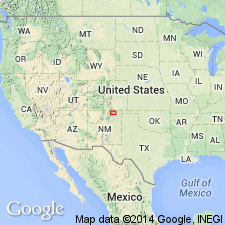
- Usage in publication:
-
- Tin Pan coal bed*
- Modifications:
-
- First used
- Dominant lithology:
-
- Coal
- AAPG geologic province:
-
- Las Vegas-Raton basin
Summary:
First use of name; intent to name not stated, and no type locality designated. Origin of name not stated. Underlies an area of about 40 sq mi--mostly north of the Canadian River, beginning about 4 mi west of Raton--in the eastern part of Raton coal field, Colfax Co, NM, Las Vegas-Raton basin. Is a coal bed in Raton Formation, located in the upper, coal-bearing division of three field divisions of Raton Formation. Raton Formation is overlain by Paleocene Poison Canyon Formation, and overlies Late Cretaceous Vermejo Formation--Vermejo conformably overlies Trinidad Sandstone but is locally absent beneath the base of overlying Raton Formation. Tin Pan lies 850-900 ft above the Trinidad Sandstone. Is as much as 9.5 ft thick near Brilliant; but, individual beds in the coal zone rarely reach thicknesses greater than 5 ft, and the bed contains one or more shale partings. Crops out in many canyons adjacent to and along the Canadian River. Is of Paleocene age.
Source: GNU records (USGS DDS-6; Denver GNULEX).
For more information, please contact Nancy Stamm, Geologic Names Committee Secretary.
Asterisk (*) indicates published by U.S. Geological Survey authors.
"No current usage" (†) implies that a name has been abandoned or has fallen into disuse. Former usage and, if known, replacement name given in parentheses ( ).
Slash (/) indicates name conflicts with nomenclatural guidelines (CSN, 1933; ACSN, 1961, 1970; NACSN, 1983, 2005, 2021). May be explained within brackets ([ ]).

